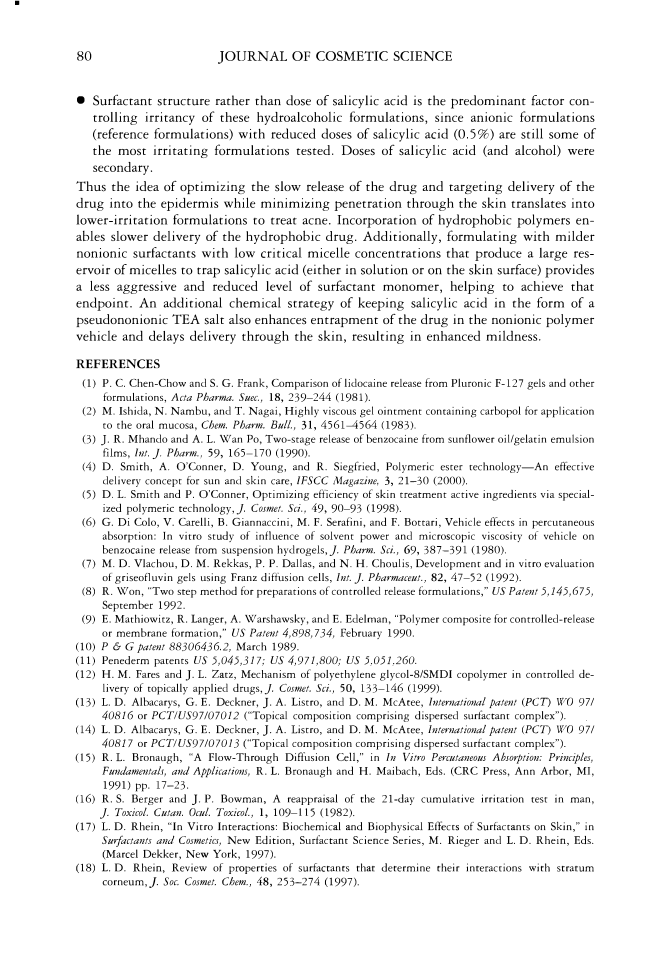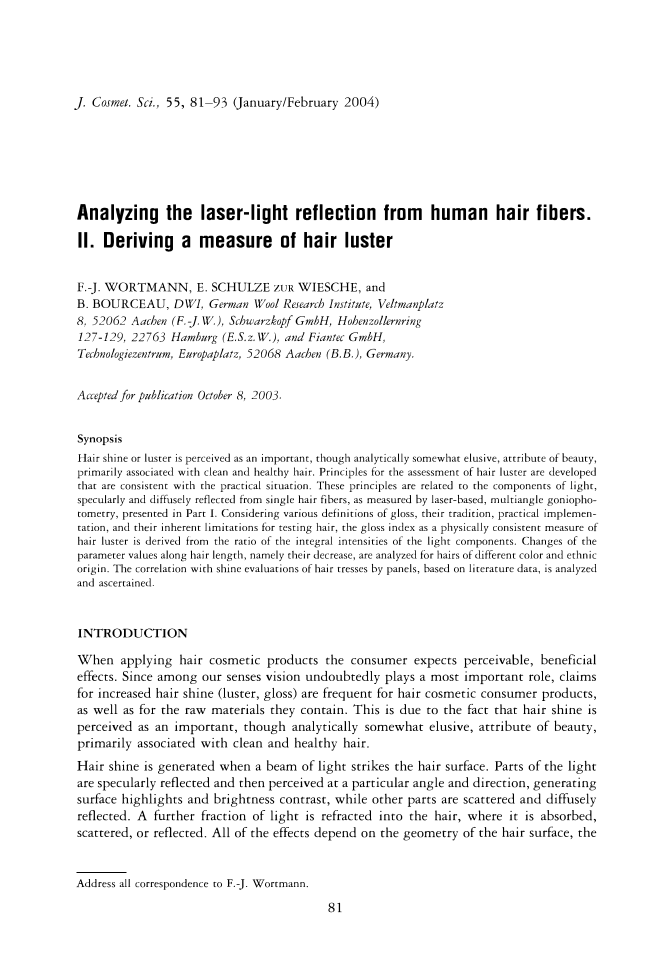■ 80 JOURNAL OF COSMETIC SCIENCE • Surfactant structure rather than dose of salicylic acid is the predominant factor con trolling irritancy of these hydroalcoholic formulations, since anionic formulations (reference formulations) with reduced doses of salicylic acid (0.5%) are still some of the most irritating formulations tested. Doses of salicylic acid (and alcohol) were secondary. Thus the idea of optimizing the slow release of the drug and targeting delivery of the drug into the epidermis while minimizing penetration through the skin translates into lower-irritation formulations to treat acne. Incorporation of hydrophobic polymers en ables slower delivery of the hydrophobic drug. Additionally, formulating with milder nonionic surfactants with low critical micelle concentrations that produce a large res ervoir of micelles to trap salicylic acid (either in solution or on the skin surface) provides a less aggressive and reduced level of surfactant monomer, helping to achieve that endpoint. An additional chemical strategy of keeping salicylic acid in the form of a pseudononionic TEA salt also enhances entrapment of the drug in the nonionic polymer vehicle and delays delivery through the skin, resulting in enhanced mildness. REFERENCES (1) P. C. Chen-Chow and S. G. Frank, Comparison of lidocaine release from Pluronic F-127 gels and other formulations, Acta Pharma. Suec., 18, 239-244 (1981). (2) M. Ishida, N. Nambu, and T. Nagai, Highly viscous gel ointment containing carbopol for application to the oral mucosa, Chem. Pharm. Bull., 31, 4561--4564 (1983). (3) J. R. Mhando and A. L. Wan Po, Two-stage release of benzocaine from sunflower oil/gelatin emulsion films, Int.]. Pharm., 59, 165-170 (1990). (4) D. Smith, A. O'Conner, D. Young, and R. Siegfried, Polymeric ester technology-An effective delivery concept for sun and skin care, IFSCC Magazine, 3, 21-30 (2000). (5) D. L. Smith and P. O'Conner, Optimizing efficiency of skin treatment active ingredients via special ized polymeric technology,]. Cosmet. Sci., 49, 90-93 (1998). (6) G. Di Colo, V. Carelli, B. Giannaccini, M. F. Serafini, and F. Bottari, Vehicle effects in percutaneous absorption: In vitro study of influence of solvent power and microscopic viscosity of vehicle on benzocaine release from suspension hydrogels,j. Phann. Sci., 69, 387-391 (1980). (7) M. D. Vlachou, D. M. Rekkas, P. P. Dallas, and N. H. Choulis, Development and in vitro evaluation of griseofluvin gels using Franz diffusion cells, Int.]. Pharmaceut., 82, 47-52 (1992). (8) R. Won, "Two step method for preparations of controlled release formulations," US Patent 5,145,675, September 1992. (9) E. Mathiowitz, R. Langer, A. Warshawsky, and E. Edelman, "Polymer composite for controlled-release or membrane formation," US Patent 4,898,734, February 1990. (10) P & G patent 88306436.2, March 1989. (11) Penederm patents US 5,045,317 US 4,971,800 US 5,051,260. (12) H. M. Fares and J. L. Zatz, Mechanism of polyethylene glycol-8/SMDI copolymer in controlled de livery of topically applied drugs,]. Cosmet. Sci., 50, 133-146 (1999). (13) L. D. Albacarys, G. E. Deckner, J. A. Listro, and D. M. McAtee, International patent (PCD WO 97/ 40816 or PCTIUS97/07012 ("Topical composition comprising dispersed surfactant complex"). (14) L. D. Albacarys, G. E. Deckner, J. A. Listro, and D. M. McAtee, International patent (PCT) WO 97/ 40817 or PCT!US97/07013 ("Topical composition comprising dispersed surfactant complex"). (15) R. L. Bronaugh, "A Flow-Through Diffusion Cell," in In Vitro Percutaneous Absorption: Principles, Fundamentals, and Applications, R. L. Bronaugh and H. Maibach, Eds. (CRC Press, Ann Arbor, MI, 1991) pp. 17-23. (16) R. S. Berger and J.P. Bowman, A reappraisal of the 21-day cumulative irritation test in man, ]. Toxicol. Cutan. Ocul. Toxicol., 1, 109-115 (1982). (1 7) L. D. Rhein, "In Vitro Interactions: Biochemical and Biophysical Effects of Surfactants on Skin," in Surfactants and Cosmetics, New Edition, Surfactant Science Series, M. Rieger and L. D. Rhein, Eds. (Marcel Dekker, New York, 1997). (18) L. D. Rhein, Review of properties of surfactants that determine their interactions with stratum corneum,J. Soc. Cosmet. Chem., 48, 253-274 (1997).
J. Cosmet. Sci., 55, 81-93 CTanuary/February 2004) Analyzing the laser-light reflection from human hair fibers. II. Deriving a measure of hair luster F.-J. WORTMANN, E. SCHULZE zuR WIESCHE, and B. BOURCEAU, DWI, German Wool Research Institute, Veltmanplatz 8, 52062 Aachen (F.-j. W.), Schwarzkopf GmbH, Hohenzollernring 127-129, 22763 Hamburg (E.S.z. W.), and Fiantec GmbH, Technologiezentrum, Europaplatz, 52068 Aachen (B.B.), Germany. Accepted for publication October 8, 2003. Synopsis Hair shine or luster is perceived as an important, though analytically somewhat elusive, attribute of beauty, primarily associated with clean and healthy hair. Principles for the assessment of hair luster are developed that are consistent with the practical situation. These principles are related to the components of light, specularly and diffusely reflected from single hair fibers, as measured by laser-based, multiangle goniopho tometry, presented in Part I. Considering various definitions of gloss, their tradition, practical implemen tation, and their inherent limitations for testing hair, the gloss index as a physically consistent measure of hair luster is derived from the ratio of the integral intensities of the light components. Changes of the parameter values along hair length, namely their decrease, are analyzed for hairs of different color and ethnic origin. The correlation with shine evaluations of hair tresses by panels, based on literature data, is analyzed and ascertained. INTRODUCTION When applying hair cosmetic products the consumer expects perceivable, beneficial effects. Since among our senses vision undoubtedly plays a most important role, claims for increased hair shine (luster, gloss) are frequent for hair cosmetic consumer products, as well as for the raw materials they contain. This is due to the fact that hair shine is perceived as an important, though analytically somewhat elusive, attribute of beauty, primarily associated with clean and healthy hair. Hair shine is generated when a beam of light strikes the hair surface. Parts of the light are specular! y reflected and then perceived at a particular angle and direction, generating surface highlights and brightness contrast, while other parts are scattered and diffusely reflected. A further fraction of light is refracted into the hair, where it is absorbed, scattered, or reflected. All of the effects depend on the geometry of the hair surface, the Address all correspondence to F.-J. Wortmann. 81
Purchased for the exclusive use of nofirst nolast (unknown) From: SCC Media Library & Resource Center (library.scconline.org)





































































































































